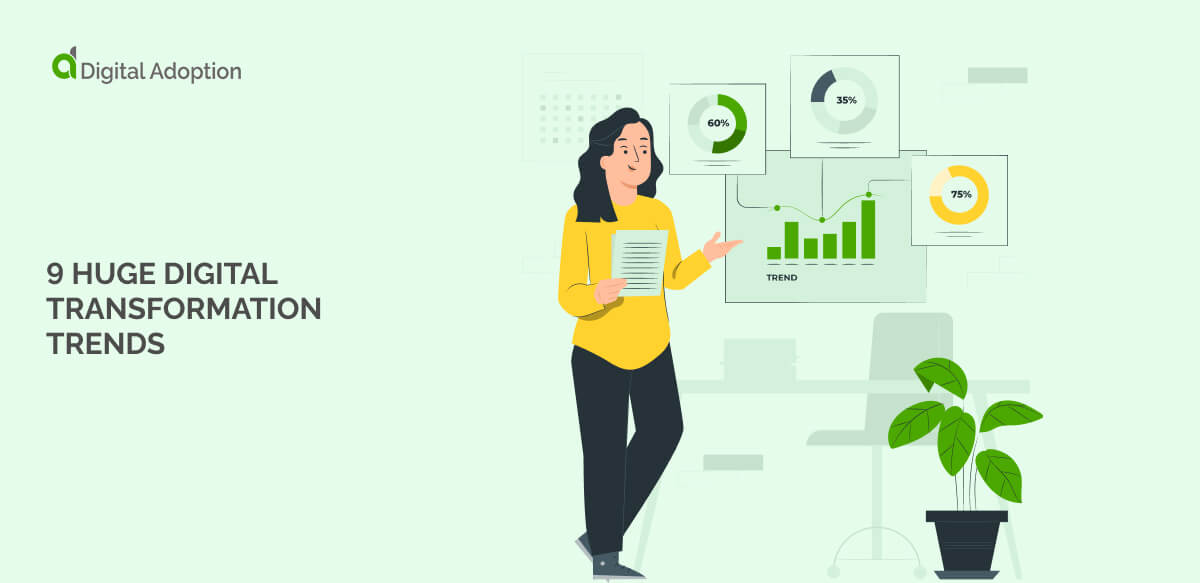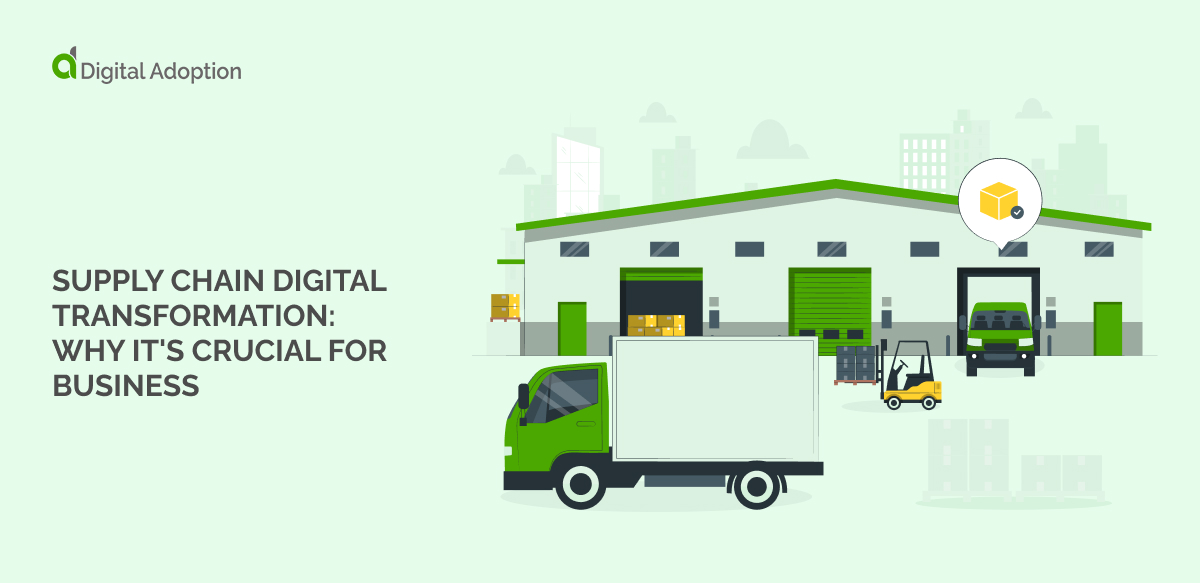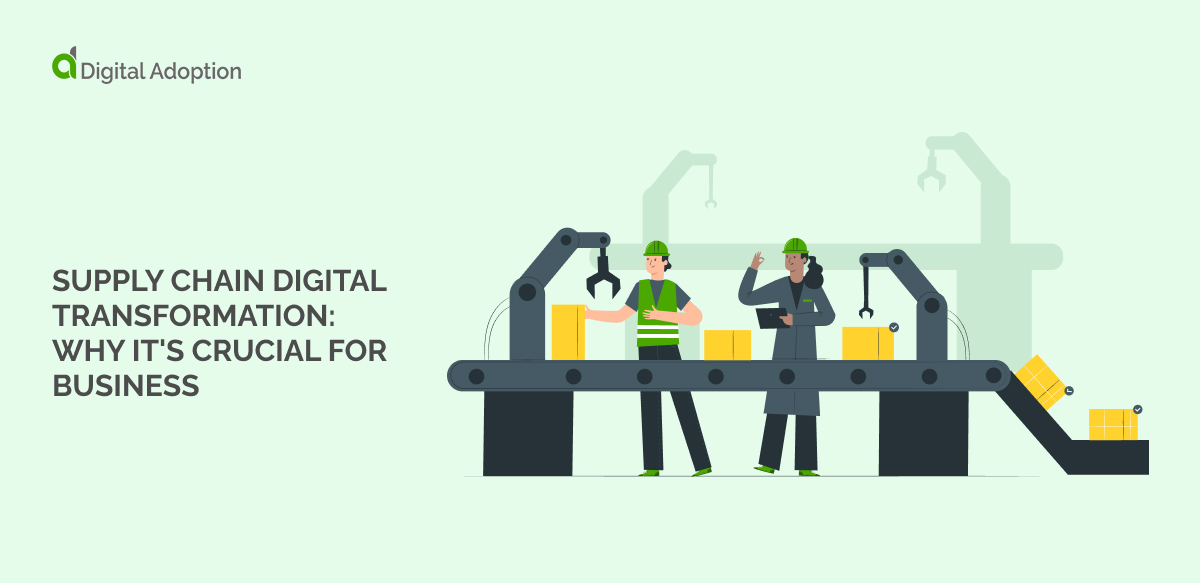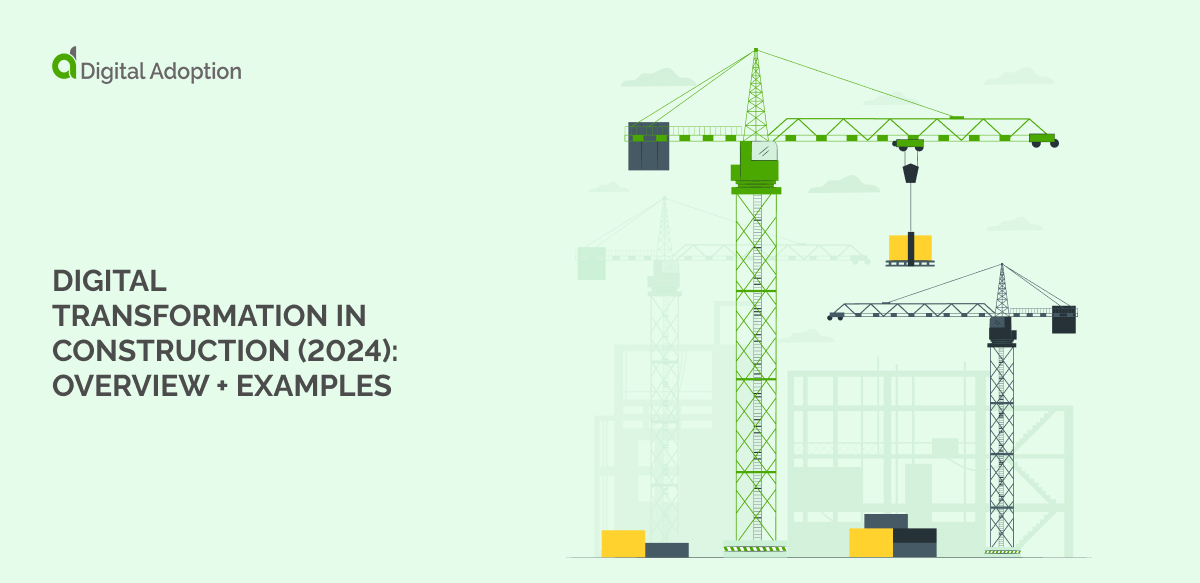The last few years have been hectic for business leaders.
How we work has been turned on its head, market shifts are wild and unpredictable, and we’ve had to learn to adapt faster than ever.
We’ve all realized how important it is to stay on top of trends and foresee disruptive change- so we’ve written this article to help you do just that.
This article covers 9 big digital transformation trends that have been on the rise.
At its core, digital transformation is the integration of digital technology into all areas of your business, profoundly changing how you operate and deliver value to your customers.
It’s about more than just buying the latest tech tool; it’s about using digital adoption to shape and reshape your business in the digital age.
Today we’re talking about everything from AI and ML, 5G and edge computing, Everything as a Service (XaaS), and much more.
As we delve into these topics, you’ll gain insights into what these trends mean for your business and how to leverage them for success.
- Trend #1: Embracing simplicity with low-code/no-code platforms
- Trend #2: Multi-cloud architecture – a modern approach
- Trend #3: Democratization of AI and ML – power to the people
- Trend #4: Intelligent search – beyond basic queries
- Trend #5: Automation – efficiency at scale
- Trend #6: Blockchain – beyond cryptocurrencies
- Trend #7: Customer Data Platforms – understanding your audience
- Demystifying customer data platforms
- Trend #8: XaaS – the flexible future
- Trend #9: 5G and Edge Computing – revolutionizing connectivity
- Navigating the digital transformation landscape
Trend #1: Embracing simplicity with low-code/no-code platforms
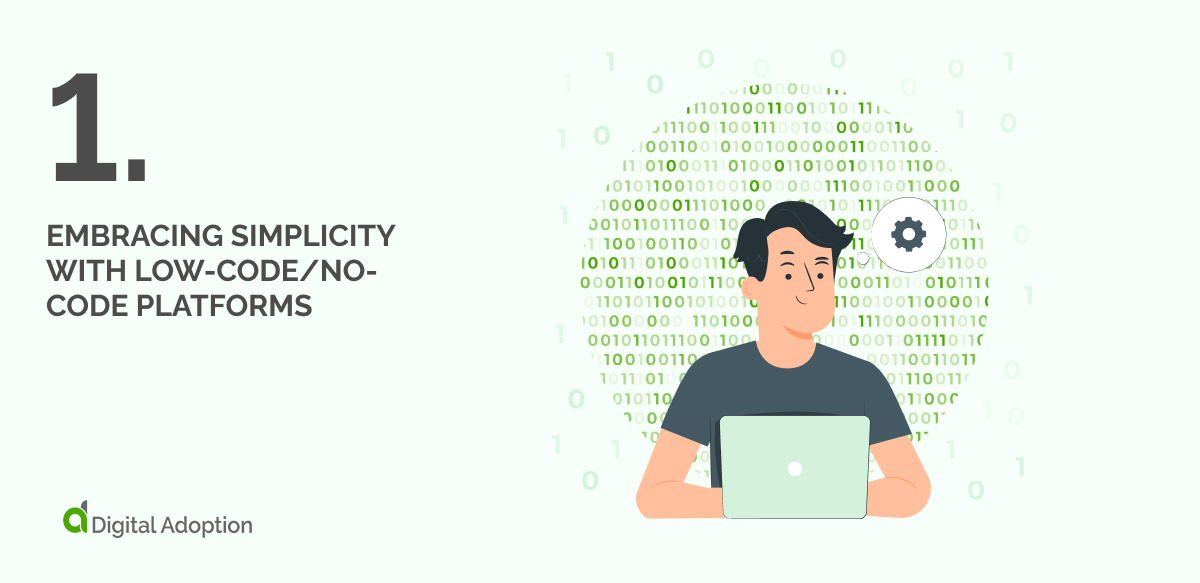
Have you ever thought about creating a custom application for your business but been deterred by limitations like costs, time, or lack of technical expertise?
Low-code and no-code platforms are an up-and-coming solution.
Understanding low-code and no-code platforms
At a basic level, low-code platforms help you build applications with minimal manual coding, typically using a graphical user interface (GUI).
These platforms speed up your software development process.
On the flip side, no-code platforms cater to you even if you have no coding background at all, with intuitive drag-and-drop tools and ready-to-use functions.
The business impact: efficiency and innovation
Low-code and no-code platforms are transformative.
They shorten your time to market, letting you swiftly pivot as business needs evolve.
By lowering the entry barriers to app development, they allow teams from different backgrounds to collaborate and innovate.
Challenges and the road ahead
Of course, there are bumps on the road.
The ease of no-code might sometimes restrict you when you need more complex solutions. And while low-code offers depth, it might demand some tech oversight, potentially stretching thin tech teams.
But the silver lining? When harnessed right, these tools could democratize app development, paving the way for quick innovation in businesses of all sizes.
These platforms might soon become the bedrock of enterprise app development. They’ll enable you to dynamically adapt to market changes, keep innovation in your crosshairs, and stay a step ahead of the competition.
Trend #2: Multi-cloud architecture – a modern approach
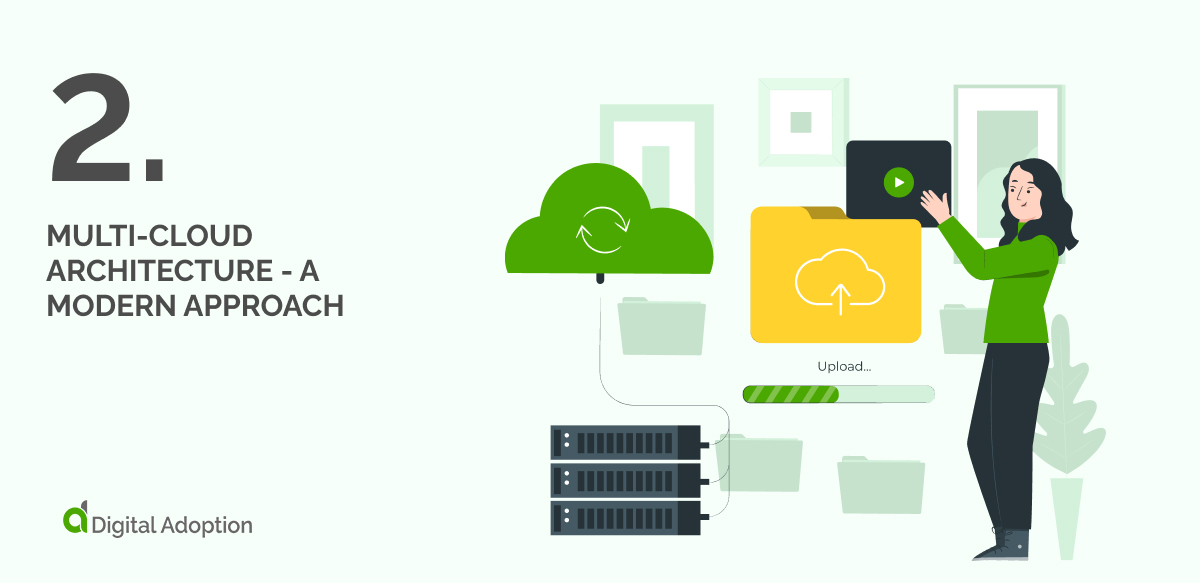
If you’ve been exploring ways to enhance your company’s IT infrastructure, you might have stumbled upon the term “multi-cloud.”
But what does it mean, and why should you care about it?
Defining multi-cloud architecture
Multi-cloud architecture uses two or more cloud computing services from different vendors within a single network architecture.
Unlike a single cloud provider, this approach allows you to choose various services and solutions that best fit your unique business needs.
Why businesses like yours are turning to multi-cloud
Flexibility and adaptation: You can pick and choose the best offerings from different vendors, allowing for a more tailored solution.
Risk mitigation: By spreading your data and applications across multiple providers, you reduce the risk of vendor lock-in and potential downtime.
Cost optimization: You have the ability to negotiate better pricing and avoid unnecessary expenses by leveraging the most cost-effective services from each provider.
A look into the future of cloud computing
The multi-cloud approach isn’t just a fleeting trend; it’s shaping the future of cloud computing.
We foresee more intelligent management tools emerging to simplify multi-cloud operations, integration of AI to enhance optimization, and a more prominent focus on sustainability within cloud services.
Understanding and embracing multi-cloud architecture could be a strategic move if you’re considering a shift to the cloud or looking to optimize your existing cloud strategy.
It’s about leveraging the strengths of different providers to craft a solution tailored to your business.
Trend #3: Democratization of AI and ML – power to the people
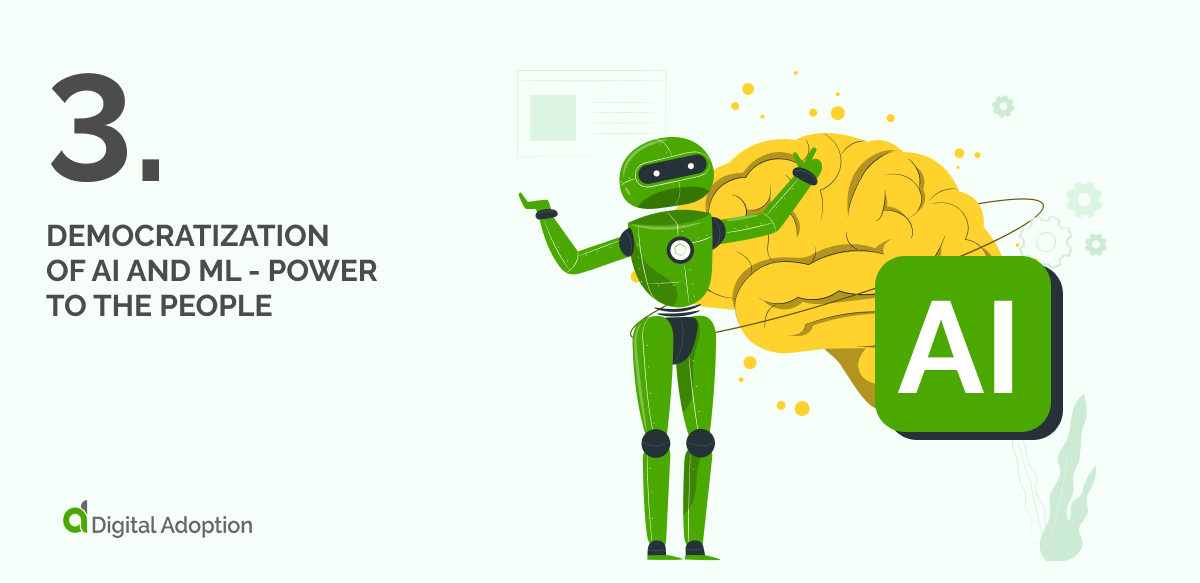
Picture this: A world where advanced technologies like Artificial Intelligence (AI) and Machine Learning (ML) aren’t just confined to tech giants or exclusive research labs.
Instead, they’re accessible and usable by anyone, irrespective of your technical proficiency.
We’ve already seen huge developments in this trend this year alone. According to Mckinsey, generative AI is poised to add as much as $4.4 trillion in economic value by increasing productivity across the board.
Forrester Analyst Rowan Curran predicts that 10% of employees overall will use generative AI in 2023.
How much further could it go?
Understanding the democratization of AI and ML
The democratization of AI and ML means making these technologies accessible to a wider audience.
It’s about breaking down barriers so that you, regardless of your technical background, can leverage these powerful tools to address unique challenges or innovate in your industry.
Shifting dynamics across industries and roles
The ripple effect of AI and ML democratization is profound, from healthcare to finance.
Medical professionals can use AI-enhanced tools for better diagnosis and personalized patient care.
Marketing executives can tap into AI-powered analytics tools to derive actionable insights and drive campaigns.
Manufacturing floor managers can leverage AI for predictive maintenance, optimizing production lines without deep technical expertise.
Navigating ethical waters and governance
But as with any powerful tool, there are challenges.
The ease of access can lead to misuse or unintended consequences:
Bias and fairness: If not careful, AI models can perpetuate or even amplify existing biases.
You’ll need to ensure that models are trained on diverse and representative datasets.
Transparency and accountability: Knowing how decisions are made is crucial, especially in sensitive sectors like finance or healthcare.
Implementing governance structures can help ensure AI acts in predictable and transparent ways.
Peering into the crystal ball: What’s next?
As AI and ML become more intertwined in our daily lives, you can expect:
Increased accessibility: More platforms will emerge, catering to people with varying levels of expertise.
Collaborative AI: Systems that allow human and machine intelligence to collaborate seamlessly.
Ethical standards: As discussions around AI ethics intensify, expect more established guidelines and best practices to surface.
Trend #4: Intelligent search – beyond basic queries
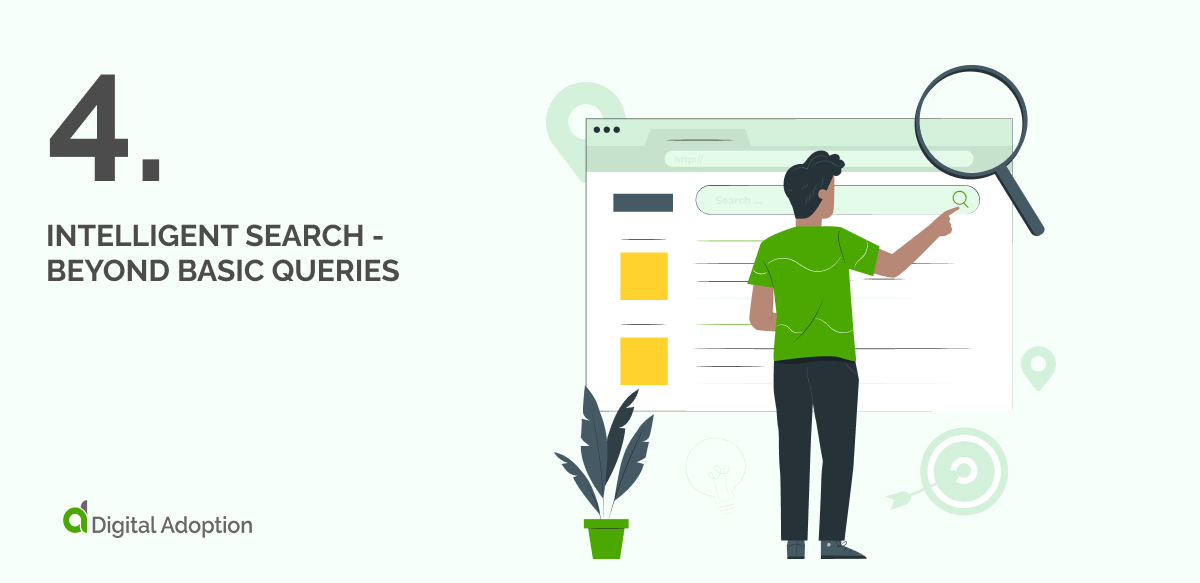
Do you recall the last time you typed a query into a search engine and were amazed by its uncanny ability to know exactly what you were thinking?
Gone are the days when search engines simply matched keywords.
Today’s intelligent search dives deeper, understands context, and often predicts your next move.
Diving into intelligent search technology
Intelligent search, often infused with AI and ML capabilities, understands the user’s intent, context, and often even emotions behind a query.
This kind of search doesn’t just rely on keyword matching.
Instead, it interprets data, learns from user behavior, and continually refines its results, offering you information that’s more relevant than ever.
For businesses, this is groundbreaking. Here’s why:
Personalized user experiences: Websites can now offer tailored content recommendations based on search habits, ensuring visitors find what they need faster.
Enhanced productivity: For companies with vast internal databases, employees can quickly find and analyze the exact data they need, driving better decision-making.
Market insights: By analyzing search behaviors, businesses can gain insights into market trends, helping them stay ahead of the curve.
Forecasting the future of intelligent search
Looking ahead, you can anticipate:
Voice search dominance: With the rise of smart assistants, voice will become a primary medium for search.
Visual and Augmented Reality (AR) search: Searching through images or using AR to overlay data in the real world will become more mainstream.
Continuous learning: Search engines will get even better at learning from real-time user interactions, refining their algorithms on the fly.
Intelligent search isn’t just a fancy tech term. It’s reshaping how you access and interact with information daily.
The era of intelligent search promises more relevance, depth, and context than ever before. Keeping abreast of its developments could give you a distinct edge in our data-driven world.
Trend #5: Automation – efficiency at scale
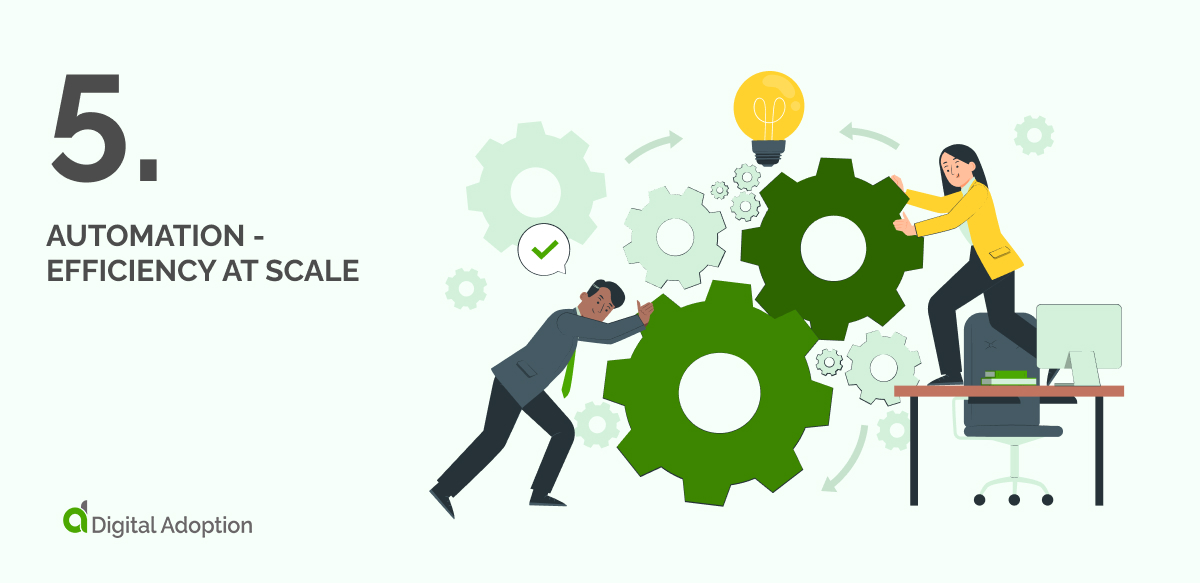
Automation isn’t just about robots in factories.
It spans digital platforms, tools, and even decision-making processes.
Unpacking automation and its many facets
Automation refers to the use of technology to perform tasks without human intervention. It can manifest in various forms:
Robotic Process Automation (RPA): Software ‘robots’ mimic human actions, like data entry or invoice processing.
Industrial automation: Machines take over repetitive tasks in manufacturing or production lines.
Digital automation: Think of those email marketing campaigns triggered by specific user behaviors.
Where automation is concerned, no industry remains untouched.
From healthcare to retail to finance- there’s no business that can’t reap at least some of the benefits of automation, such as:
Efficiency and speed: Tasks get done faster and often with fewer errors.
Cost savings: Over time, you can reduce operational costs.
Scalability: As your business grows, automation can easily adapt to handle increased loads.
But, there are potential drawbacks to consider.
As machines and software take over, some jobs may become obsolete, and over-reliance on automation can pose risks if systems fail.
Peeking into the future: What’s next in automation?
Automation isn’t just about cutting costs or speeding up processes.
It’s a pathway to reimagine workflows, enhance employee productivity, and drive innovation.
In the future, we might see these automation trends gain momentum:
Hyperautomation Platforms: Combining multiple automation tools together, expect a surge in systems that not only automate tasks but also make decisions based on vast data sets.
Collaborative robots: Instead of replacing humans, robots will work alongside you, enhancing your capabilities.
Emotion AI: Automation tools might soon gauge human emotions and adapt their responses accordingly, creating more intuitive interactions.
Trend #6: Blockchain – beyond cryptocurrencies

When you hear the word “blockchain,” do you instantly think of cryptocurrencies like Bitcoin?
While it’s true that blockchain underpins these digital currencies, this technology’s potential extends far beyond just digital coins.
Decoding blockchain technology
At its core, blockchain is a distributed ledger technology.
This means that instead of a central authority holding all the records, the information is spread across a network of computers.
Each “block” of data is chained to the previous one, ensuring that it’s nearly impossible to alter once information is added without changing every subsequent block.
Far from being confined to the realm of finance, blockchain technology could benefit a wide range of industries.
Here are a few examples:
Supply chain management: Companies can trace products from source to customer, ensuring authenticity and transparency.
Healthcare: Patient records are securely stored and can be seamlessly shared between providers while ensuring data privacy.
Real estate: The buying and selling process becomes more streamlined, with transparent transaction records and reduced fraud risks.
Voting systems: Some countries are exploring blockchain to create tamper-proof election voting systems.
Building on trust, transparency, and security
Blockchain’s allure lies in its foundational principles: Trust, transparency, and security.
But blockchain’s journey isn’t without challenges:
As a relatively new technology, regulatory environments in many countries are still catching up.
Also, with so many blockchain platforms and protocols, there’s a need for standard practices to ensure interoperability and consistency.
Finally, despite its potential, some associate blockchain only with the volatile world of cryptocurrencies, necessitating broader education on its wider applications.
Trend #7: Customer Data Platforms – understanding your audience
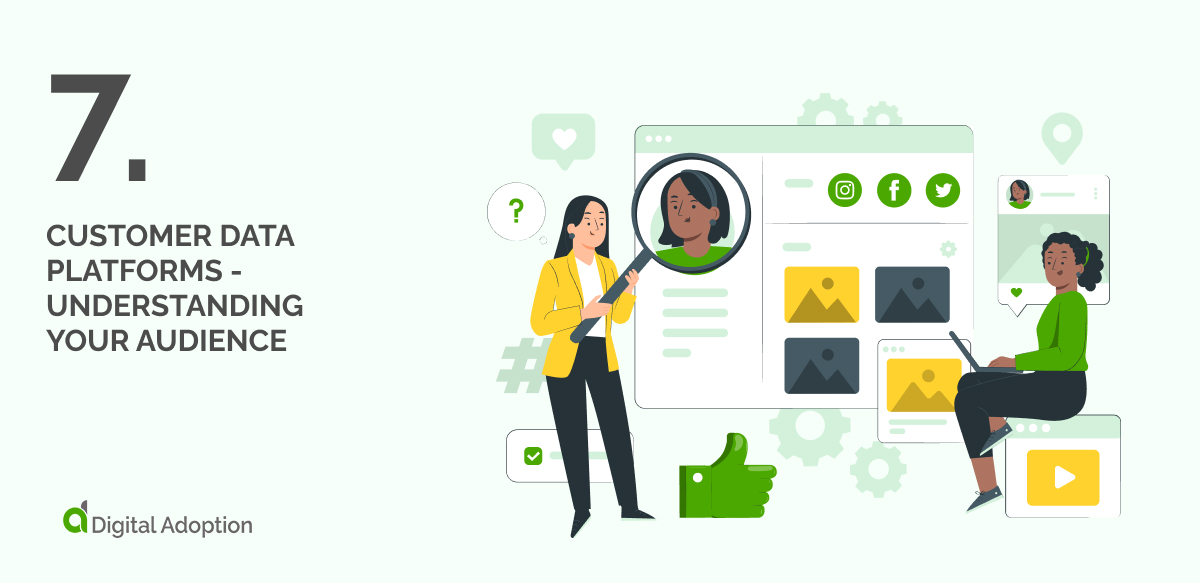
In the vast ocean of digital data, wouldn’t it be great to have a compass that helps you understand your customers’ needs, behaviors, and preferences?
Enter Customer Data Platforms (CDPs).
Let’s delve deeper.
Demystifying customer data platforms
A Customer Data Platform (CDP) is software that aggregates and organizes customer data from various sources into a single, comprehensive view.
This unified profile helps you understand and engage with each individual customer at a personalized level.
With CDPs, you no longer have to piece together data from different silos. You get a 360-degree view of your customer, spanning their buying habits, preferences, interactions, and more.
You can tailor your marketing campaigns with detailed customer insights to resonate with individual preferences, enhancing customer experience and conversion rates.
Understanding the customer journey lets you predict their needs and proactively address concerns, leading to improved loyalty and satisfaction.
Balancing insights with privacy
Here’s the catch:
In an era where data privacy concerns loom large, you must ensure transparency about the data you collect and its use.
You also have to stay updated with regulations like GDPR or CCPA. Non-compliance can lead to hefty penalties and reputational damage.
Data is powerful, but it’s not without its challenges.
Charting the future of customer data platforms
As you look ahead, what can you expect?
Integration with AI: Enhanced by AI, CDPs could offer predictive insights, helping you foresee customer trends and preferences.
Real-time data processing: Future CDPs will likely operate in real-time, offering instant insights based on ongoing customer interactions.
Extended data sources: Beyond traditional digital footprints, CDPs might incorporate data from IoT devices, wearables, or even voice assistants.
In a nutshell, Customer Data Platforms serve as your window into the world of your customers. Understanding and harnessing the power of CDPs can redefine how you engage with your audience, making interactions more meaningful and outcomes more fruitful.
Trend #8: XaaS – the flexible future
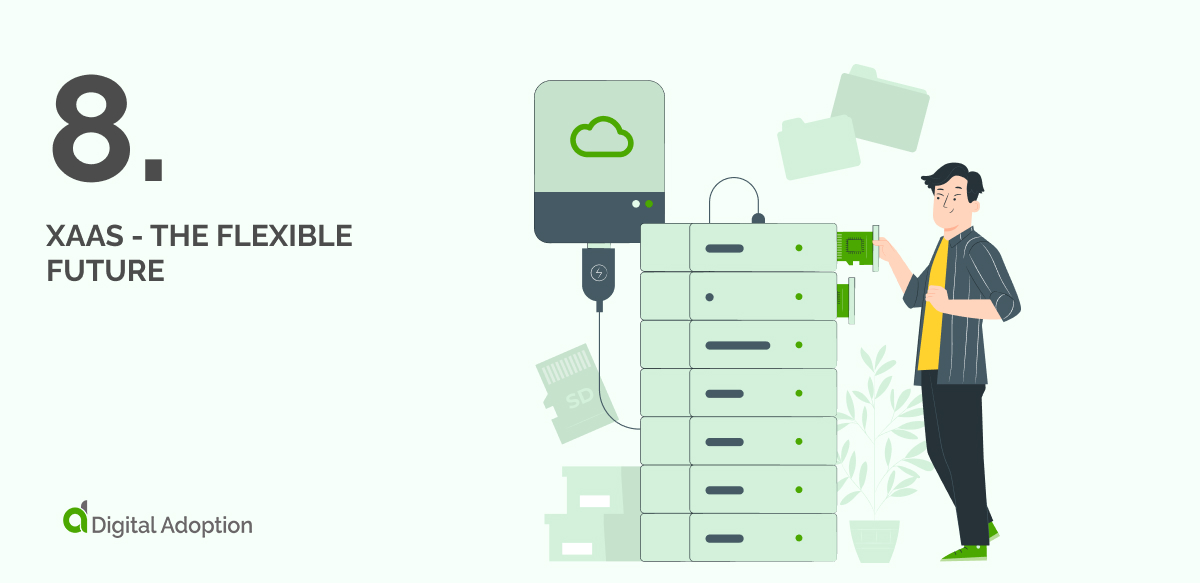
Imagine having the flexibility to access various services, from software to platforms and even entire infrastructures, without owning or managing them.
With XaaS, or “Everything as a Service,” you can do exactly that.
Let’s explore this transformative trend that’s reshaping how you conduct business.
Defining XaaS (Everything as a Service)
XaaS encompasses a wide array of services delivered over the internet.
Instead of purchasing, maintaining, or updating specific technologies, you can subscribe to what you need when you need it.
Think of it as a buffet of digital services where you only pay for what you consume.
The XaaS revolution in business models
How is XaaS altering the way businesses like yours operate?
Flexibility: You can quickly adapt to market changes by scaling services up or down.
Cost efficiency: No more hefty investments in technology that might soon become obsolete. You invest in what you need.
Innovation acceleration: With access to cutting-edge tools and platforms, you can innovate without the burdens of technology management.
Customization: Providers often offer tailored solutions to fit your unique business needs, allowing for a more aligned strategy.
Gazing into the future of XaaS
What’s on the horizon for XaaS?
More specialized services: Expect to see even more niche services tailored to specific industry needs.
Intelligent automation: AI and machine learning might soon enhance XaaS offerings, leading to smarter, more responsive services.
Global collaboration: XaaS will likely enable even more international cooperation, breaking down geographical barriers in business operations.
For business leaders steering into the digital future, XaaS offers a tantalizing promise of flexibility, cost efficiency, and relentless innovation.
Trend #9: 5G and Edge Computing – revolutionizing connectivity
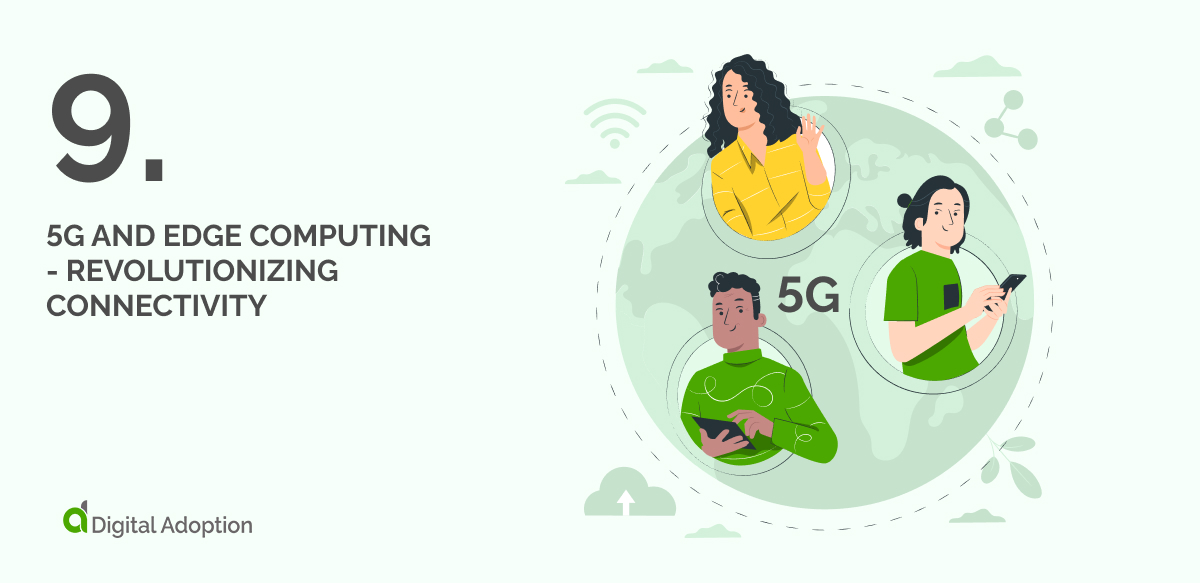
Speed, responsiveness, and near-instantaneous data processing are just a few hallmarks of the modern digital age.
Both 5G technology and edge computing stand at the forefront of this new era. Let’s dive into how they’re setting the stage for the next generation of connectivity.
Introducing 5G technology and edge computing
Simply put, 5G is the fifth generation of mobile network technology, succeeding 4G.
It promises significantly faster data download and upload speeds, wider coverage, and more stable connections.
As for edge computing, instead of sending data to distant data centers or clouds for processing, devices process data closer to the data source, be it a smartphone, an IoT device, or sensors.
5G provides the blazingly fast and reliable connectivity edge computing devices require to process data on the spot.
In return, edge computing ensures that 5G bandwidth isn’t clogged with unnecessary data, only transmitting what’s essential.
Together, they ensure you get real-time or near-real-time data processing and insights.
Redefining industries: from IoT to AR/VR
The combined prowess of 5G and edge computing has transformative implications for several applications:
IoT (Internet of Things): Devices can now communicate and process data seamlessly, paving the way for smarter cities, homes, and industries.
AR/VR (Augmented Reality/Virtual Reality): With reduced latency, experiences become more immersive and responsive. Think of AR tools for designers or VR in education.
Autonomous vehicles: Real-time data processing is crucial for safety and navigation.
Telemedicine: Doctors can perform remote consultations or surgeries with reliable, real-time data streams.
Looking ahead: the promising horizon
As you strategize for the future, expect to see these drivers for 5G and edge computing technologies:
Increased convergence: Expect even tighter integration between 5G and edge computing, resulting in more hybrid solutions.
Greener solutions: As research continues, expect more energy-efficient devices and networks.
Beyond 5G: Even as 5G rolls out, discussions on 6G and its potential are already in motion.
For forward-thinking business leaders, the combined might of 5G and edge computing offers a tantalizing glimpse into the future of digital connectivity.
Navigating the digital transformation landscape
Navigating the digital realm today can feel like exploring a vast, interconnected galaxy. While distinct in its own right, each trend forms part of a greater constellation, shaping our digital future.
On top of that, if you want to buy into these trends and see an ROI, it’s not enough to simply buy digital tools.
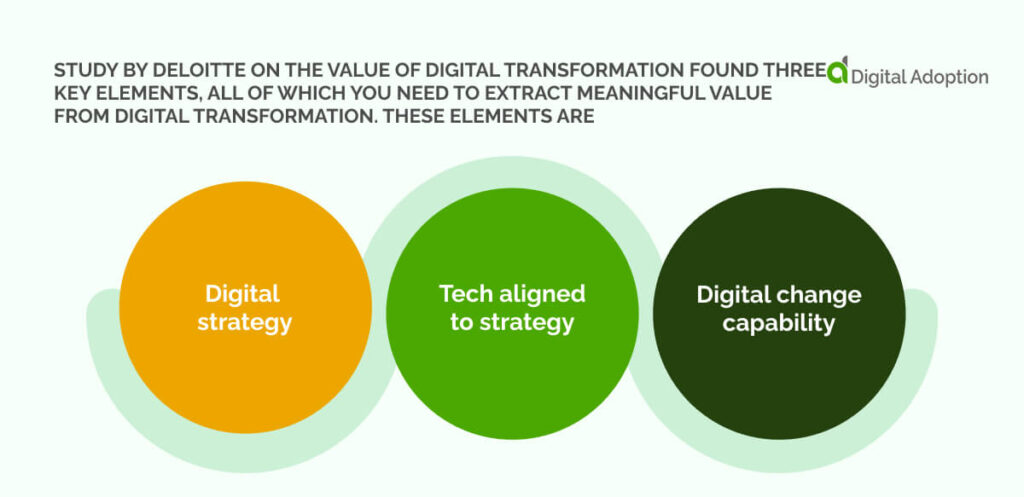
A study by Deloitte on the value of digital transformation found three key elements, all of which you need to extract meaningful value from digital transformation. These elements are
- Digital strategy
- Tech aligned to strategy
- Digital change capability
Failing to have all three of these elements can drastically decrease the return on investment you see in digital transformation.
While each trend offers unique value, its interconnectedness is undeniable.
For instance, the growth of IoT is intrinsically linked to the capabilities of 5G and edge computing. Similarly, the democratization of AI gains momentum with platforms offered as XaaS.
Recognizing these synergies is crucial for holistic digital strategies.
These trends herald a shift in operations, strategy, and even company culture. There’s an undeniable push towards being more adaptive, data-driven, and customer-centric.
Individual professionals, on the other hand, will find the landscape ripe with opportunities for upskilling and navigating new career paths.
The digital realm waits for no one.
It’s vital to not just be a passive observer and actively engage, experiment, and adapt. Seek out collaborations, invest in continuous learning, and be open to pivoting when needed.

